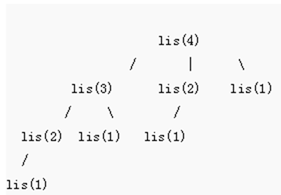在 Dynamic Programming | Set 1 (Overlapping Subproblems Property) 和 Dynamic Programming | Set 2 (Optimal Substructure Property) 中我们已经讨论了重叠子问题和最优子结构性质,现在我们来看一个可以使用动态规划来解决的问题:最长上升子序列(Longest Increasing Subsequence(LIS))。
最长上升子序列问题,致力于在一个给定的序列中找到一个最长的子序列,该子序列中的元素按升序排列。例如,序列{10, 22, 9, 33, 21, 50, 41, 60, 80}的最长上升子序列的长度为6,最长上升子序列为{10, 22, 33, 50, 60, 80}。
Optimal Substructure:
假设arr[0..n-1]为输入数组,L(i)是以下标i结束的数组的最长上升子序列的长度,满足arr[i]是LIS的一部分,即arr[i]是该LIS中的最后一个元素,那么L(i)可以递归的表示为:
L(i) = { 1 + Max ( L(j) ) } where j < i and arr[j] < arr[i] and if there is no such j then L(i) = 1
要获得一个给定数组LIS的长度,我们需要返回 max(L(i)) where 0 < i < n。
因此,LIS问题具有最优子结构性质,因此该问题可以使用子问题的方法来求解。
Overlapping Subproblems:
以下是LIS问题的一个简单递归版本程序。
/* A Naive recursive implementation of LIS problem */
#include<stdio.h>
#include<stdlib.h>
/* To make use of recursive calls, this function must return two things:
1) Length of LIS ending with element arr[n-1]. We use max_ending_here
for this purpose
2) Overall maximum as the LIS may end with an element before arr[n-1]
max_ref is used this purpose.
The value of LIS of full array of size n is stored in *max_ref which is our final result
*/
int _lis( int arr[], int n, int *max_ref)
{
/* Base case */
if(n == 1)
return 1;
int res, max_ending_here = 1; // length of LIS ending with arr[n-1]
/* Recursively get all LIS ending with arr[0], arr[1] ... ar[n-2]. If
arr[i-1] is smaller than arr[n-1], and max ending with arr[n-1] needs
to be updated, then update it */
for(int i = 1; i < n; i++)
{
res = _lis(arr, i, max_ref);
if (arr[i-1] < arr[n-1] && res + 1 > max_ending_here)
max_ending_here = res + 1;
}
// Compare max_ending_here with the overall max. And update the
// overall max if needed
if (*max_ref < max_ending_here)
*max_ref = max_ending_here;
// Return length of LIS ending with arr[n-1]
return max_ending_here;
}
// The wrapper function for _lis()
int lis(int arr[], int n)
{
// The max variable holds the result
int max = 1;
// The function _lis() stores its result in max
_lis( arr, n, &max );
// returns max
return max;
}
/* Driver program to test above function */
int main()
{
int arr[] = { 10, 22, 9, 33, 21, 50, 41, 60 };
int n = sizeof(arr)/sizeof(arr[0]);
printf("Length of LIS is %d
", lis( arr, n ));
getchar();
return 0;
}
考虑以上实现,如下是当数组大小为4时的递归树,lis(n)为以n为最后一个元素时,数组的LIS的长度。
不难发现,其中有子问题被重复计算。因此,该问题具有重叠子结构性质,通过Memoization或者Tabulation,可以防止子问题的重复计算。如下,是LIS问题的tabluated实现。
/* Dynamic Programming implementation of LIS problem */
#include<stdio.h>
#include<stdlib.h>
/* lis() returns the length of the longest increasing subsequence in
arr[] of size n */
int lis( int arr[], int n )
{
int *lis, i, j, max = 0;
lis = (int*) malloc ( sizeof( int ) * n );
/* Initialize LIS values for all indexes */
for ( i = 0; i < n; i++ )
lis[i] = 1;
/* Compute optimized LIS values in bottom up manner */
for ( i = 1; i < n; i++ )
for ( j = 0; j < i; j++ )
if ( arr[i] > arr[j] && lis[i] < lis[j] + 1)
lis[i] = lis[j] + 1;
/* Pick maximum of all LIS values */
for ( i = 0; i < n; i++ )
if ( max < lis[i] )
max = lis[i];
/* Free memory to avoid memory leak */
free( lis );
return max;
}
/* Driver program to test above function */
int main()
{
int arr[] = { 10, 22, 9, 33, 21, 50, 41, 60 };
int n = sizeof(arr)/sizeof(arr[0]);
printf("Length of LIS is %d
", lis( arr, n ) );
getchar();
return 0;
}
注意,以上的动态规划解法需要的时间复杂度为O(n^2),实际上LIS问题有O(nLogn)的解法(see this)。在这边,我们并没有讨论O(nLogn)的解法,此处,只是用这篇文章来作为动态规划的一个简单例子。
补充一个最笨的方法:将所有的子序列使用dfs枚举出来,看其最大长度是多少,代码如下:
#include <iostream>
#include <vector>
using namespace std;
void dfs(const vector<int> &input, vector<vector<int> > &ret, vector<int> &path, int pos) {
if (pos == input.size()) {
ret.push_back(path);
return;
}
for (int i = 0; i != 2; i++) {
if (i == 0) {
path.push_back(input[pos]);
dfs(input, ret, path, pos + 1);
path.pop_back();
} else {
dfs(input, ret, path, pos + 1);
}
}
}
int main()
{
vector<int> input = {1,2,3};
cout << "input.size() = " << input.size() << endl;
vector<vector<int>> ret;
vector<int> path;
dfs(input, ret, path, 0);
for (vector<vector<int> >::const_iterator itr = ret.begin(); itr != ret.end(); itr++) {
cout << "--" << " ";
for (vector<int>::const_iterator it = itr->begin(); it != itr->end(); it++) {
cout << *it << " ";
}
cout << endl;
}
}
/*
Output:
-- 1 2 3
-- 1 2
-- 1 3
-- 1
-- 2 3
-- 2
-- 3
--
*/
